

Renewed Push to Give Obama an Internet "Kill Switch" Senate Homeland Security and Governmental Affairs Committee Chairman Sen.
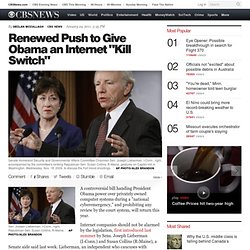
Joseph Lieberman, I-Conn., right, accompanied by the committee's ranking Republican Sen. Susan Collins, R-Maine, gestures on Capitol Hill in Washington, Wednesday, Nov. 18, 2009, to discuss the Fort Hood shootings. AP Photo/Alex Brandon A controversial bill handing President Obama power over privately owned computer systems during a "national cyberemergency," and prohibiting any review by the court system, will return this year. Internet. Homeland Security must disclose ‘Internet Kill Switch,' court rules. The Department of Homeland Security (DHS) must disclose its plans for a so-called Internet “kill switch,” a federal court ruled on Tuesday.

Internet kill switch. An Internet kill switch is the cybercrime and countermeasures concept of activating a single shut off mechanism for all Internet traffic.
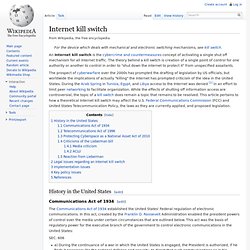
The theory behind a kill switch is creation of a single point of control for one authority or another to control in order to "shut down the internet to protect it" from unspecified assailants. The prospect of cyberwarfare over the 2000s has prompted the drafting of legislation by US officials, but worldwide the implications of actually "killing" the Internet has prompted criticism of the idea in the United States.
During the Arab Spring in Tunisia, Egypt, and Libya access to the Internet was denied [1] in an effort to limit peer networking to facilitate organization. Who Owns the Internet? ICANN. The Internet Corporation for Assigned Names and Numbers (ICANN, /ˈaɪkæn/ EYE-kan) is a nonprofit organization that coordinates the Internet's global domain name system.

The Internet Assigned Numbers Authority (IANA) is a department of ICANN responsible for managing the DNS Root and the numbering system for IP addresses. ICANN was created on September 18, 1998, and incorporated on September 30, 1998.[1] It is headquartered in the Playa Vista section of Los Angeles, California. Internet topology. Internet topology is the network topology of the Internet.
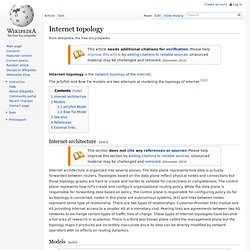
The Jellyfish and Bow Tie models are two attempts at modeling the topology of Internet.[1][2] Internet architecture[edit] Internet architecture is organized into several planes. The data plane represents how data is actually forwarded between routers. Topologies based on the data plane reflect physical nodes and connections but these topology graphs are hard to create and harder to validate for correctness or completeness. Models[edit] Fortunately, nobody owns the Internet, there is no centralized control, and nobody can turn it off.
Jellyfish Model[edit] Bow Tie Model[edit] The Bow Tie model comprises four main groups of web pages. A more comprehensive representation of the Bow Tie model has been presented with additional, smaller groups of web pages. See also[edit] World-Information.Org. How ARPANET Works" How old do you think the Internet is?
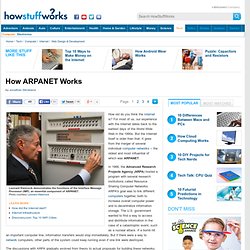
For most of us, our experience with the Internet dates back to the earliest days of the World Wide Web in the 1990s. But the Internet itself is older than that. It grew from the merger of several individual computer networks -- the oldest and most influential of which was ARPANET. In 1966, the Advanced Research Projects Agency (ARPA) hosted a program with several research institutions called Resource Sharing Computer Networks.
ARPA's goal was to link different computers together, both to increase overall computer power and to decentralize information storage. The discussions with ARPA gradually evolved from theory to actual proposals for building these networks. The team that designed, built and installed ARPANET was diverse, consisting of electrical engineers, computer scientists, applied mathematicians and graduate students. How did the Internet start. Who owns the Internet. Imagine you're in a room full of people from different countries, and everyone only speaks his or her native language.

In order to communicate, you'd have to come up with a standard set of rules and vocabulary. That's what makes the Internet so remarkable: It's a system that lets different computer networks communicate with each other using a standardized set of rules. Without rules, these computer networks wouldn't be able to communicate with each other. Who Owns the Internet? A report from the Internet Governance Forum. Who owns the Internet?
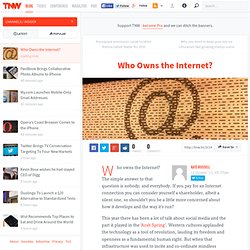
The simple answer to that question is nobody; and everybody. If you pay for an Internet connection you can consider yourself a shareholder, albeit a silent one, so shouldn’t you be a little more concerned about how it develops and the way it’s run? This year there has been a lot of talk about social media and the part it played in the ‘Arab Spring‘. Western cultures applauded the technology as a tool of revolution, lauding its freedom and openness as a fundamental human right. But when that infrastructure was used to incite and co-ordinate mindless violence and looting in the UK riots, those same voices were heard whispering about shutting down networks to stem the free flow of information that could be used for spurious means. Internet under siege. Defense Advanced Research Projects Agency. Who Owns the Internet? Build Your Own Internet with Mobile Mesh Networking.
After an earthquake crippled Haiti in 2010, killing and injuring hundreds of thousands and destroying the country’s communication networks, Paul Gardner-Stephen found himself thinking about all the cell phones that had instantly become useless.

With cell towers out of commission across the country, they would be unable to operate. “If the software on the phones was right,” he says, “they would keep working for at least localized communication, handset to handset.” Gardner-Stephen, a research fellow at Flinders University in Adelaide, Australia, now leads a project that enables Android phones to do just that. Serval, as the project is called, offers an app that allows nearby phones to link up using their Wi-Fi connections, as long as they have been modified to disable the usual security restrictions. Voice calls, text messages, file transfers, and more can take place between devices with the Serval app installed. The range of Wi-Fi poses a technical challenge for mesh networks. Rural Towns Frustrated By Big Telecom Are Just Building Their Own Internet. In the industrialized world, the Internet is no longer a luxury.

Yet according to Monday's Pew Research Center study, 30 percent of Americans still lack online access. Maybe it's time to take matters into their own hands. Communities beyond U.S. borders are showing the way. In rural Lancashire, England, the residents of one village have begun digging trenches and installing their own fiber optic cables. To make their homemade network run, the BBC reports, they've enlisted everyone from a "Lancaster University professor who is an expert in computer networks" to a "farmer's wife who has just retired from a career in IT support. " "Farmers are being told they have to fill in forms online," Barry Forde of the Lancashire effort told the BBC.